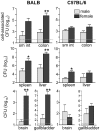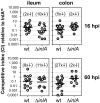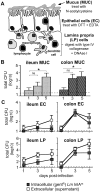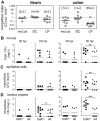InlA promotes dissemination of Listeria monocytogenes to the mesenteric lymph nodes during food borne infection of mice
- PMID: 23166492
- PMCID: PMC3499570
- DOI: 10.1371/journal.ppat.1003015
InlA promotes dissemination of Listeria monocytogenes to the mesenteric lymph nodes during food borne infection of mice
Abstract
Intestinal Listeria monocytogenes infection is not efficient in mice and this has been attributed to a low affinity interaction between the bacterial surface protein InlA and E-cadherin on murine intestinal epithelial cells. Previous studies using either transgenic mice expressing human E-cadherin or mouse-adapted L. monocytogenes expressing a modified InlA protein (InlA(m)) with high affinity for murine E-cadherin showed increased efficiency of intragastric infection. However, the large inocula used in these studies disseminated to the spleen and liver rapidly, resulting in a lethal systemic infection that made it difficult to define the natural course of intestinal infection. We describe here a novel mouse model of oral listeriosis that closely mimics all phases of human disease: (1) ingestion of contaminated food, (2) a distinct period of time during which L. monocytogenes colonize only the intestines, (3) varying degrees of systemic spread in susceptible vs. resistant mice, and (4) late stage spread to the brain. Using this natural feeding model, we showed that the type of food, the time of day when feeding occurred, and mouse gender each affected susceptibility to L. monocytogenes infection. Co-infection studies using L. monocytogenes strains that expressed either a high affinity ligand for E-cadherin (InlA(m)), a low affinity ligand (wild type InlA from Lm EGDe), or no InlA (ΔinlA) showed that InlA was not required to establish intestinal infection in mice. However, expression of InlA(m) significantly increased bacterial persistence in the underlying lamina propria and greatly enhanced dissemination to the mesenteric lymph nodes. Thus, these studies revealed a previously uncharacterized role for InlA in facilitating systemic spread via the lymphatic system after invasion of the gut mucosa.
Conflict of interest statement
The authors have declared that no competing interests exist.
Figures







References
-
- Bartt R (2000) Listeria and atypical presentations of Listeria in the central nervous system. Semin Neurol 20: 361–373. - PubMed
-
- Munoz P, Rojas L, Bunsow E, Saez E, Sanchez-Cambronero L, et al. (2011) Listeriosis: An emerging public health problem especially among the elderly. J Infect 64: 19–33. - PubMed
-
- Ooi ST, Lorber B (2005) Gastroenteritis due to Listeria monocytogenes . Clin Infect Dis 40: 1327–1332. - PubMed
Publication types
MeSH terms
Substances
Grants and funding
LinkOut - more resources
Full Text Sources
Other Literature Sources
Medical

